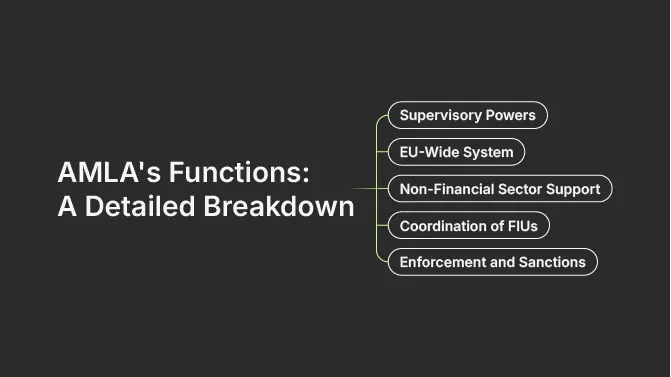In December 2023, the EU Council and Parliament reached a provisional agreement to establish a new European authority for combating money laundering and terrorist financing: the Anti-Money Laundering Authority (AMLA). This new institution is a key part of the EU’s broader strategy to strengthen its defenses against financial crime. Here’s what you need to know about AMLA’s purpose, powers, and expected impact.
AMLA Meaning and Purpose
AMLA stands for the Anti-Money Laundering Authority. Its purpose is to serve as the central EU-level body responsible for overseeing and coordinating anti-money laundering (AML) and counter-terrorist financing (CTF) efforts across member states. The authority is designed to increase the effectiveness of AML supervision, especially in high-risk and cross-border financial activity.
What Is AMLA’s Role in Financial Regulation?
The European Union’s AMLA is primarily aimed at strengthening the region’s response to money laundering, terrorism financing, and related unlawful activities. Created under the Anti-Money Laundering Act (AMLA Regulation), the agency establishes a centralized authority for cross-border coordination and enforcement.
AMLA’s core roles include:
- Exercising direct and indirect supervisory powers over high-risk entities in the financial sector.
- Developing comprehensive systems with national supervisors to ensure consistent AML/CTF compliance across borders.
- Supporting non-financial sectors through guidance, coordination, and indirect oversight.
- Coordinating the work of Financial Intelligence Units (FIUs) across EU member states.
- Imposing sanctions for serious, repeated, or systematic violations of AML regulations.
These responsibilities make AMLA a cornerstone of the EU’s harmonized approach to financial regulation, with implications not only for banks but also for other entities subject to reporting requirements.
AMLA’s Functions: A Detailed Breakdown

Supervisory Powers over High-Risk Entities
AMLA has both direct and indirect supervisory authority over institutions deemed high-risk by national regulators or the agency itself. This applies to financial institutions such as banks, fintech companies, and payment providers that operate across borders or present complex risk profiles.
Under its implementing rules, AMLA can step in when local supervision proves ineffective or fragmented, ensuring that AML compliance is upheld uniformly. These powers are essential in addressing unlawful activities such as cross-border terrorism financing, complex fraud schemes, or large-scale money laundering.
Building a Harmonized EU-Wide System
AMLA is tasked with creating a comprehensive regulatory framework that integrates national supervisory practices into a single European standard. This involves issuing guidelines, monitoring enforcement, and benchmarking performance across jurisdictions.
Such harmonization is critical for reducing regulatory arbitrage and closing loopholes that allow money laundering activities to go undetected across borders. Government agencies and regulators in member states must align with AMLA’s interpretations of core principles and adopt its implementing rules into national law.
Support for Non-Financial Sectors
While its oversight is most direct in the financial sector, AMLA also plays a key coordinating role for other entities such as lawyers, accountants, real estate professionals, and luxury goods dealers. These sectors often have reporting requirements under AML laws but lack dedicated supervisory bodies.
AMLA supports national regulators in these domains by issuing best practices, risk assessments, and compliance guidance. It ensures that such information is accessible and actionable across sectors that are less familiar with regulatory expectations but equally vulnerable to abuse.
Coordination of Financial Intelligence Units (FIUs)
One of AMLA’s pivotal roles is to coordinate the work of FIUs, the national bodies responsible for collecting, analyzing, and disseminating reports of suspicious financial activity. Historically, FIU cooperation has been uneven due to jurisdictional limitations and technical incompatibilities.
AMLA will create an integrated data hub and standardized procedures to enhance the exchange of intelligence across borders, improving the detection of complex, transnational unlawful activities. These efforts will empower FIUs to act more swiftly and effectively in tandem with government agencies and law enforcement.
Enforcement and Sanctions
When institutions fail to meet their obligations under the Anti Money Laundering Act, AMLA has the authority to impose administrative penalties. This includes fines and other sanctions for systematic violations or non-compliance with reporting requirements.
AMLA also plays a consultative role in advising the European Commission and the attorney general-equivalent bodies in member states on enforcement priorities. This ensures that AMLA’s interventions support both national autonomy and the EU’s broader regulatory integrity.
AMLA’s Supervisory Powers

Under the provisional agreement establishing the Anti Money Laundering Authority (AMLA), the agency is granted extensive supervisory powers. These powers are primarily aimed at ensuring uniform implementation of anti-money laundering and counter-terrorism financing regulations across the European Union.
AMLA’s supervisory mandate includes:
- Direct oversight of up to 40 high-risk financial groups and entities operating across member states.
- Leading joint supervisory teams to assess and inspect selected institutions, including crypto-asset service providers.
- Establishing a central supervisory database to track relevant AML/CFT information and support coordination between national authorities.
- Ensuring compliance with targeted financial sanctions, including procedures for asset freezes and confiscations.
- Supporting national oversight efforts in the non-financial sector by issuing recommendations and assisting supervisory colleges.
- Exercising binding dispute resolution authority within financial supervisory colleges in certain cross-border regulatory disagreements.
These enhanced powers reflect the EU’s strategic shift toward centralized coordination and enforcement of AML compliance, particularly in areas where government agencies have faced challenges due to fragmentation, resource gaps, or jurisdictional limits.
AMLA Supervisory Powers: A Deeper Dive
Targeted Financial Sanctions
AMLA will ensure that selected obligated entities—especially high-risk financial institutions—have implemented robust internal policies for enforcing targeted financial sanctions. This includes not only routine screening and reporting but also concrete procedures for asset freezes, confiscations, and restrictions tied to unlawful activities such as terrorism financing or state-sponsored financial crimes. Entities under AMLA’s supervision must demonstrate their ability to comply with evolving regulatory requirements, maintain audit trails, and act swiftly upon updates to EU-wide sanction lists. These enforcement mechanisms are central to AMLA’s role in coordinating anti money laundering efforts across jurisdictions.
Governance
The structure of AMLA has been designed to balance independence, representation, and EU oversight. A general board will be established, comprising representatives from national supervisory authorities and Financial Intelligence Units (FIUs) across all EU member states. This board will facilitate cross-border coordination and policy consistency. In addition, an executive board—composed of AMLA’s chair and five independent, full-time members—will act as the main governing body. Importantly, the Council and Parliament have agreed to remove the European Commission’s veto right over certain functions of the executive board, particularly those related to budgetary decisions. This adjustment enhances AMLA’s autonomy in financial oversight and reinforces its ability to enforce the Anti Money Laundering Act without undue political interference.
Whistleblowing
A key innovation introduced by the provisional agreement is AMLA’s enhanced whistleblowing mechanism, which is primarily aimed at increasing transparency and accountability in the fight against financial crime. The Authority will exclusively manage reports submitted by the financial sector regarding obligated entities, including banks, payment institutions, and crypto-asset service providers. Furthermore, AMLA will be empowered to receive and assess whistleblower reports originating from employees of national authorities, a move that strengthens internal compliance culture and encourages early reporting of unlawful activities within supervisory structures.
Disagreements
To resolve regulatory inconsistencies and supervisory conflicts, AMLA will hold binding dispute resolution authority within financial supervisory colleges. These colleges—multilateral forums made up of national regulators—sometimes face friction when assessing cross-border institutions. AMLA’s intervention in such cases ensures uniform application of implementing rules, the fair treatment of supervised entities, and the minimization of regulatory gaps. The Authority may also be called upon by a financial supervisor to issue binding decisions in cases that fall outside of these colleges but still impact cross-jurisdictional cooperation.
Ongoing Negotiations
Negotiations continue between the Council and the European Parliament concerning two additional legislative instruments: the regulation addressing anti-money laundering requirements for the private sector, and the directive establishing national-level anti-money laundering mechanisms. These parallel legislative efforts aim to complement AMLA’s central role by aligning the obligations of other entities, such as real estate professionals and auditors, with the broader framework. Once finalized, they will establish a more coherent legal structure and ensure that government agencies across the EU are equipped to meet new reporting requirements, enforce the Anti Money Laundering Act, and collaborate more effectively in identifying and preventing unlawful activities.
Timeline: AMLA Setup and Next Steps
In 2024, the final agreement text on the establishment of the Anti Money Laundering Authority (AMLA) is scheduled for review and approval by member state representatives and the European Parliament. This milestone marks a crucial step toward implementing a harmonized regulatory framework across the European Union, primarily aimed at combating money laundering and terrorism financing.
Between 2026 and 2027, AMLA is expected to commence direct supervision of selected high-risk financial institutions operating across EU member states. These entities will be subject to centralized oversight, reporting requirements, and compliance procedures developed in line with EU-wide standards.
Several critical components of AMLA’s operational setup are currently in progress. Negotiations over the Authority’s physical seat remain ongoing, with member states competing to host the new agency. At the same time, the EU AML coordination group has outlined 80 technical standards—comprising implementing technical standards (ITS) and regulatory technical standards (RTS)—to serve as the backbone of the new AML rulebook. These standards will support the application of implementing rules and define how institutions, government agencies, and other entities must align their compliance processes.
Additionally, supervisory procedures are being designed to support effective AMLA-led oversight. This includes the development of joint supervisory team structures, cross-border collaboration mechanisms, and bilateral agreements with both EU and non-EU partners. These measures will ensure that AMLA’s regulatory reach is both consistent and adaptable, enabling robust enforcement.
AMLA and Whistleblower Protections
The provisional agreement introduces a strengthened whistleblowing framework within AMLA’s mandate:
- AMLA will receive and investigate reports from financial sector employees concerning obligated entities.
- It will have authority to review whistleblower reports submitted by staff of national regulatory authorities.
- This centralized function ensures whistleblowers have a secure and trusted EU-level channel, improving transparency and early detection of AML/CTF breaches.
How AMLA Will Impact Financial Institutions
The creation of AMLA represents a significant regulatory shift for:
- Banks and credit institutions: High-risk or cross-border operators will be subject to direct supervision, requiring tighter internal AML controls.
- Fintech and crypto firms: Particularly those operating across multiple jurisdictions, must prepare for coordinated oversight and enhanced transparency.
- Compliance teams: Must align internal policies with EU-wide standards and prepare for potential AMLA-led assessments or inspections.
Institutions not directly supervised by AMLA will still experience heightened scrutiny via strengthened national regulators operating within the EU-wide framework.



